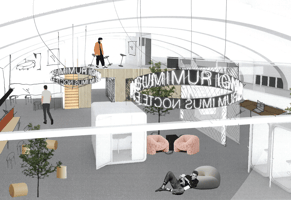Inspired by an article published on 9.11.2021 and written by Veera Luoma-aho from HS Visio, and by...
Is the office thermal map getting hotter or colder? Artificial intelligence helps us to communicate better
.png?width=768&name=heatmap_workspace%20(1).png)
Researchers at the Faculty of Information Technology at the University of Jyväskylä and Workspace Oy have together developed an AI-based method that helps to visualise and develop an organisation’s interaction culture.
The new method comprises two phases, the first of which identifies and analyses interaction while protecting personal privacy. In the second phase, interaction situations are visualised in the organisation’s physical operating environment. The organisation’s interaction culture and space functionality are analysed by mapping the number and locations of interaction situations.
Speech recognition utilises open-source technology developed at MIT (the Massachusetts Institute of Technology) with recognition accuracy that was further developed during the project using AI solutions.
Visualisation helps to check where interaction situations take place, how many there are, and how complex the situations that take place on the organisation’s premises are, and also places them on an interactive timeline over the period under review. Speech recognition data used for visualisation can also be compiled and used to evaluate an organisation’s interaction culture. For example, how evenly turn-taking takes place in in dialogue, or whether people interrupt and talk over others during meetings.
“We want to better understand the interaction at the core of work. Collaboration on research accelerates our opportunities to help our customers to have even more of an impact. In late 2021, we will publish a research collaboration-based Sanoin mobile app developed to measure interaction,” says CEO Sini Norta from Workspace Oy.
Protecting privacy was of the utmost importance when developing the method
The technology used in speech recognition is restricted due to privacy protection issues. Particular attention was also paid to making sure that the speaker or their precise location could not be identified from the analysis or visualisation.
The ECCOLA method, built for developing reliable AI systems and itself developed at the University of Jyväskylä, was utilised in speech recognition, its analysis, and its visualisation.
“Results of the research project indicated that there are new and interesting applications for artificial intelligence that benefit both companies and employees,” says Professor Pekka Abrahamsson from the Faculty of Information Technology, who was responsible for the research project.
The research project was carried out as part of the American Centre for Visual and Decision Informatics.

